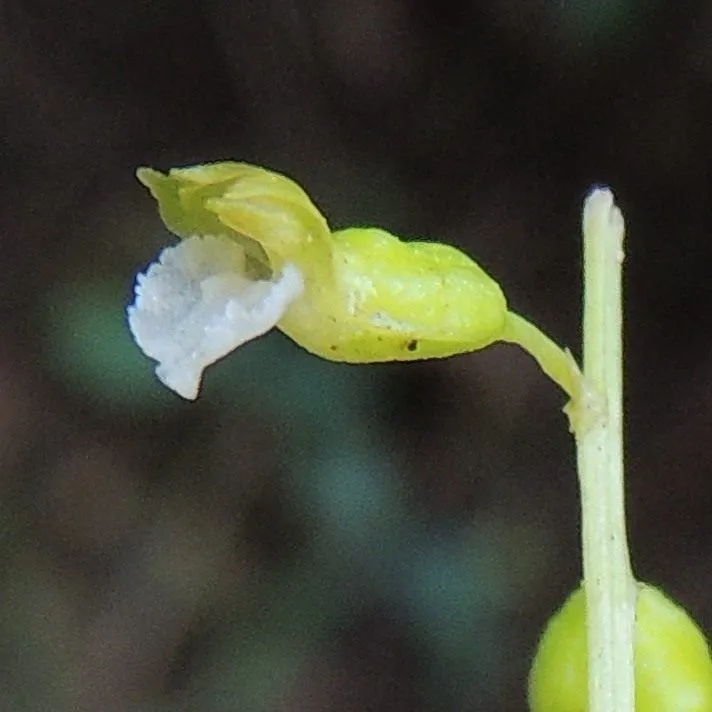
Author: (Willd.) Nutt.
Bibliography: Gen. N. Amer. Pl. 2: 197 (1818)
Year: 1818
Status: accepted
Rank: species
Genus: Corallorhiza
Vegetable: False
Observations: SE. Canada, NC. & E. U.S.A. to C. America
Autumn coralroot, scientifically known as Corallorhiza odontorhiza, is a fascinating species within the family Orchidaceae. First described by Nuttall in 1818 in the notable work “Genera of North American Plants,” this unique orchid has intrigued botanists and plant enthusiasts for centuries.
This remarkable plant is primarily found across a broad range, stretching from Southeastern Canada and the North-Central and Eastern regions of the United States down to Central America. Its ability to thrive in diverse locales is a testament to its adaptability and resilience.
Autumn coralroot is particularly noted for its distinct absence of chlorophyll, as it does not rely on photosynthesis like most other plants. Instead, it derives its nutrients through a symbiotic relationship with mycorrhizal fungi in the soil. This intriguing survival strategy classifies it as a mycoheterotroph.
This orchid typically emerges in late summer to early autumn, often gracing the forest floor with its slender, leafless stems that can grow to heights of 25-60 cm. The small, intricate flowers, ranging in colors from pale whites to purples with fine tooth-like appendages – hence the name “odontorhiza” which translates to “toothed root” in Greek – add a delicate touch to the woodland undergrowth.
Autumn coralroot favors shaded, moist, and rich woodland environments where it can best harness its unique nutritional pathway. Despite its relatively modest size, this orchid plays a critical role in its ecosystem, engaging in intricate ecological interactions that highlight the complex interdependencies among forest organisms.
In conclusion, Corallorhiza odontorhiza represents a remarkable example of botanical adaptation and symbiosis within the Orchidaceae family. Its widespread distribution and distinctive biological traits make it a compelling subject for further study and admiration among botany enthusiasts and professionals alike.
Eng: autumn coralroot, late coralroot, fall coral-root
En: Autumn coralroot, Small-flowered coral-root, Late coralroot, Fall Coral-Root
Taken Nov 14, 2014 by EOL − Robert L Curtis (cc-by-nc-sa)
© copyright of the Board of Trustees of the Royal Botanic Gardens, Kew.
© copyright of the Board of Trustees of the Royal Botanic Gardens, Kew.
© copyright of the Board of Trustees of the Royal Botanic Gardens, Kew.
Growth habit>: Forb/herb
Family: Myrtaceae Author: (F.Muell.) K.D.Hill & L.A.S.Johnson Bibliography: Telopea 6: 402 (1995) Year: 1995 Status:…
Family: Rubiaceae Author: Pierre ex A.Froehner Bibliography: Notizbl. Bot. Gart. Berlin-Dahlem 1: 237 (1897) Year:…
Family: Sapindaceae Author: Koidz. Bibliography: J. Coll. Sci. Imp. Univ. Tokyo 32(1): 38 (1911) Year:…
Family: Asteraceae Author: A.Gray Bibliography: Pacif. Railr. Rep.: 107 (1857) Year: 1857 Status: accepted Rank:…
Family: Fabaceae Author: Medik. Bibliography: Vorles. Churpfälz. Phys.-Ökon. Ges. 2: 398 (1787) Year: 1787 Status:…
Family: Aspleniaceae Author: (Cav.) Alston Bibliography: Bull. Misc. Inform. Kew 1932: 309 (1932) Year: 1932…